Tulalip Amphitheatre, Saturday July 6, 2013 8pm
Meet The B-52s & The Go-Go’s! Select From Three Different VIP Experiences!
syəcəb
Meet The B-52s & The Go-Go’s! Select From Three Different VIP Experiences!
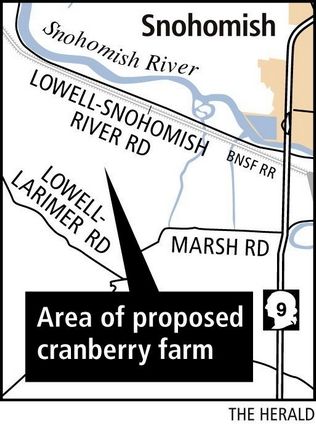 SNOHOMISH — The largest cranberry crop in Washington could be sprouting from the Snohomish River Valley a few seasons from now if a Canadian berry-grower’s plans take root.
SNOHOMISH — The largest cranberry crop in Washington could be sprouting from the Snohomish River Valley a few seasons from now if a Canadian berry-grower’s plans take root.
Golden Eagle Farms for more than a year has been buying up farmland, hundreds of acres at a time, in the floodplain south of Lowell-Snohomish River Road.
The company wants to turn most its newly acquired terrain into cranberry bogs, with a few hundred acres set aside for growing blueberries.
While blueberries have long been grown here, cranberries would be something new. Moreover, Golden Eagle’s plans would put Snohomish County at the forefront of the industry statewide.
“We’re excited about it,” said John Negrin, who oversees the renewable energy division of Golden Eagle Farms’ parent company. “This is going to be a fascinating project.”
The words “exciting” and “fascinating” came up a lot Wednesday after Negrin gave a presentation to stakeholders in Snohomish County’s Sustainable Lands Strategy. The initiative to boost farming and fish habitat in local river valleys includes farmers, environmentalists and tribal leaders, as well as members of state and local government.
Many of them liked what they heard about remaking a patch of the valley into productive berry fields, potentially bringing dozens of full-time jobs and tens of millions of dollars in investment.
“It increases land in production, using the land for the highest and best use,” said Linda Neunzig, Snohomish County’s agriculture coordinator.
Before planting, Golden Eagle Farms must convince federal, state and county authorities that it can clear regulatory hurdles.
The company can expect to spend up to a year obtaining required federal and state permits related to water quality and wetlands, said Sheila Hosner from the Governor’s Office of Regulatory Assistance.
“We’re working step by step and working with all the appropriate agencies,” Negrin said.
So far, Golden Eagle Farms has acquired about 1,500 acres in the floodplain between Everett and Snohomish. It paid more than $3.3 million a year ago for the largest piece, 900 acres that has been used for growing poplar trees. Other parcels in the area, which is known as Marshland, have been used previously for growing peas, sweet corn and broccoli, or for livestock pasture.
The areas’s abundance of water and peaty soil — drawbacks for other crops — might benefit cranberry production.
“There’s a huge investment out there in the diking and drainage systems that needs to be utilized,” said John Misich, whose family has been farming in the area since the late 1800s.
Golden Eagle Farms’ proposal would eventually put more than 1,000 acres into cranberry cultivation. The plans include more than 30 bogs of 40 acres each, Negrin said.
To put that into perspective, all current Washington cranberry farms combined total about 1,800 acres, mostly in Pacific and Grays Harbor counties.
“It would be a large farm by any stretch of the imagination,” said Kim Patten, a Washington State University Extension professor based in Long Beach. The Pacific County community is known for cranberries.
Washington’s existing cranberry farms are small and, for the most part, have been in the same family for generations, Patten said. The largest is probably about 100 acres.
Washington’s overall cranberry crop is far smaller than states such as Wisconsin, Massachusetts and New Jersey. Regionally, British Columbia’s production exceeds Washington’s many times over.
“The bulk of the industry in the Pacific Northwest is in Canada,” Patten said.
Growing cranberries is a tricky business. For starters, it takes a lot of money and know-how to get started.
The cost of establishing cranberry bogs runs up to $60,000 per acre, Negrin said. That means investment in the Snohomish County proposal could easily exceed $50 million.
Once up and running, the Snohomish Valley operations would employ an estimated 35 full-time workers, Negrin said. About 100 workers would be needed come harvest time, in September and October. Those figures do not include construction jobs.
Cranberry bogs generally need three to five years to start yielding a commercial crop.
“This is not your average farm production,” Patten said. “There is a lot of very specialized nuance here. You have to know what you’re doing. The learning curve is very steep, so I make it my job to talk people out of the business.”
That said, Golden Eagle Farms is coming to the game with lots of experience — and capital.
It already has extensive, well-established blueberry and cranberry farms in British Columbia. It’s a member of the Ocean Spray cooperative.
The landscape around its farms in the Pitt Meadows area east of Vancouver, B.C., looks remarkably similar to the Snohomish Valley, with view homes overlooking the low-lying agricultural area.
Golden Eagle Farms isn’t likely to have any trouble securing financial backing. It’s part of the Aquilini Investment Group, a multibillion-dollar Vancouver, B.C., conglomerate.
The company was founded more than 50 years ago by Italian immigrant Luigi Aquilini, who now runs the company with his three sons.
Currently, the group’s vast interests include hotels, restaurants and renewable energy projects. It also owns the Vancouver Canucks NHL team, vineyards and resorts.
Pulling off the Snohomish County project won’t come without challenges.
Cranberry production requires flooding the bogs at harvest. More water is needed for irrigation, to ward off frost damage. That means extra regulatory scrutiny, particularly for any fertilizers or pesticides that might wind up in the runoff.
There are economic unknowns, as well.
At current prices, independent cranberry growers struggled to break even, Patten said. If the berry market softens further, many could be operating at a loss.
“Right now, there’s an oversupply of cranberries on the market,” he said. “There’s been a huge planting in Quebec.”
Still, if the project comes to fruition, it could give Snohomish County a real economic boost, Patten said.
Obstacles aside, the prospect of a deep-pocketed agriculture investor who’s willing to bring a new crop to the Snohomish Valley has local farmers buzzing.
“I think everybody should be excited,” said Brian Bookey of Arlington, a member of the Snohomish County Agricultural Advisory Board. “These are folks who have their act together. I hope everybody gives them a fair shake.”
Source: The Herald, Associated Press
SEATTLE — The federal government has agreed to accept a petition that asked to have captive killer whale Lolita included in the endangered species listing for Puget Sound orcas.
Lolita was captured from that whale population in 1970 and is now at the Miami Seaquarium.
Her fellow orcas spend most of their time in Western Washington and British Columbia waters. Lolita is a member of the L pod, or family.
The National Marine Fisheries Service has listed these southern resident orcas as endangered since 2005. The wild population currently numbers 84.
People for the Ethical Treatment of Animals, which is working with other animal rights groups to have Lolita freed from captivity, filed this petition.
The decision announced Wednesday will add Lolita to a current review of the status of Puget Sound orcas as an endangered species.
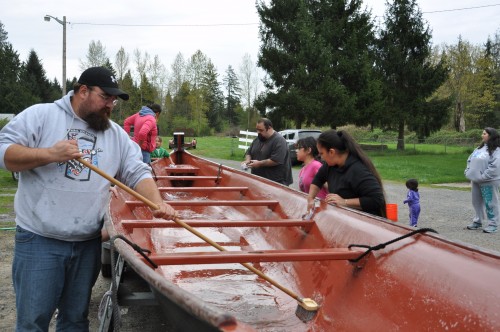
Article and photos by Monica Brown
On Wednesday, April 17th, Tulalip tribal members brought out the canoes; Big Sister, Little Sister and Big Brother, for the traditional cleaning and awakening them. This activity, referred to as protocol, is important spiritually for the canoes and tribal members.
The significance for waking the canoes is to clear any sort of negative energy that may be left over from the season before or any bad energy that may have accumulated over the winter.
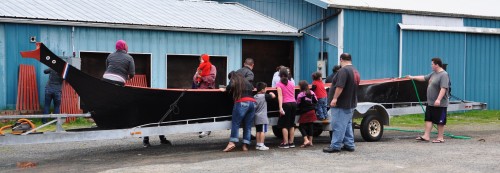
During the resting period the canoes are housed in a special canoe shed behind the Veteran’s Center. Tulalip tribal member Jason Gobin is the delegated as caretaker of the canoes and ensures that protocol is followed once the canoes are put away for the season and reawakened the following spring.
“The water is very powerful and the canoe is what takes care of us while we are out in the water,” says Tribal member and Canoe Family Skipper Darkfeather Ancheta, “Being in the Skipper position I have felt the negative energy. If the negativity is there then the canoe will not want to turn the way you are trying to make it go.”
The canoes are made from cedar trees and have a spirit giving them life for many years so they are taken care of diligently by tribal members. At the end of the season they are put to rest in their covered area until the following spring.
Canoe practice for the 2013 Canoe Journey will be held at the Tulalip Marina at 5:00 p.m. on Wednesday and is open to the community.
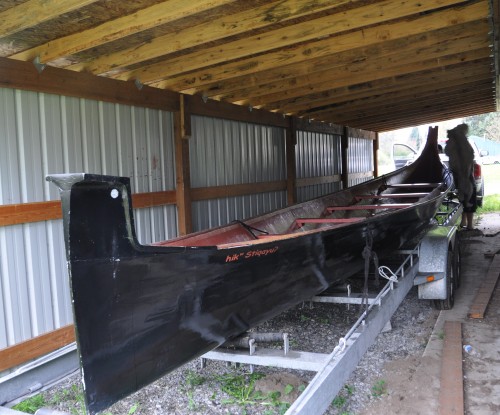
For more information, please contact Jason Gobin at 360-716-4370 or jasongobin@tulaliptribes-nsn.gov.
Source: The Herald
Brian Kertson knows a lot about cougars.
He has 11 years experience studying cougars in the Cascades and can tell you how big they get, how many kittens they have, how long they live in the wild, their favorite foods and also teach you how to identify the signs of a cougar in the woods.
You will learn all this and more at the program “Cougars” presented by the Adopt A Stream Center on Thursday.
Also, you will get to see how good a trained observer you are when Kerston shows you several “deep forest” photos and you will have to find the cougar in the picture. The first one to meet the challenge will receive an Adopt A Stream Foundation poster of sockeye salmon.
Kerston will also dispel most of the myths about cougars. There’s a lot of misinformation and myth surrounding these secretive cats, a prime predator of the Pacific Northwest forests.
Kerston will tell visitors about cougar ecology, behavior and management, and whether or not they prowl around in the suburbs.
Kerston is currently studying the potential influences of expanding housing developments on cougar-human interaction in Western Washington.
With the weather warming and hiking season not far behind, you’ll want to know more about cougars as you head into their habitat. You probably won’t see a cougar but you’ll want to know if one might be around.
“Cougars” begins at 7 p.m. Thursday at the Northwest Stream Center, McCollum Park, 600 128th St. SE, Everett.
“Cougars” is geared for sixth-graders and above. Call 425-316-8592 to reserve seats. The cost is $5 for Adopt A Stream Foundation members $5; $7 for nonmembers. For more information on this and other shows go to www.streamkeeper.org.
Movie: “Who Killed the Electric Car?” 5-8 p.m. in Gray Wolf Hall, room 286. Watch the movie ![]() about the development of an electric car in America and stay for a post-film discussion with EvCC Resource Conservation Manager Molly Beeman.
about the development of an electric car in America and stay for a post-film discussion with EvCC Resource Conservation Manager Molly Beeman.
Gardening with Ciscoe
Pacific Northwest gardening export (and TV and radio star) Ciscoe Morris![]() speaks on organic gardening and answers your questions. 1:00pm to 2:00pm in the Gray Wolf Hall Courtyard. Free and open to the public.
speaks on organic gardening and answers your questions. 1:00pm to 2:00pm in the Gray Wolf Hall Courtyard. Free and open to the public.
Plant Swap
Get all the green you want for free at the annual EvCC plant swap! Students and employees can donate plants and seeds April 24th. Want to drop off your plants early in the AM? You can bring them to Maintenance (the building behind Glacier Hall) from 7am to 9am on April 24th. Want some new vegitation? Pick up plants and share what you’ve got between Parks Building and Graywolf Hall (in the Courtyard) From 9:30am-12:30pm or until they’re gone. (You don’t have to donate anything to take a plant home.) Free and open to the public.
EvCC’s Earth Art Competition
Submit your sustainable work of art at the EvCC Earth Week “Earth Art” competition for bragging rights and valuable prize money. Click here for the 2013 Earth Art Entry Form. No project? Visit the Whitehorse Hall Critique space (Whitehorse Hall 2nd floor) between Monday, April 22nd and Thursday, April 25th to view the submissions. Vote for your favorite recycled material artwork by submitting a “people’s choice” vote and help a starving artist find fame and acclaim! EvCC Earth Art Competition projects will be displayed beginning Monday, April 22nd through Thursday, April 25th. Judging will commence from 10am-1pm, April 25th, 2013, Whitehorse Hall Critique Space. Event entry limited to current students, staff and faculty of Everett Community College. Event attendance is free and open to the public.
Click here to learn more about these events
EVERETT — If all goes as planned, Everett should have its own indoor, year-round farmers market as early as summer 2014.
Products at the Everett Farmers Market are likely to include fruits and vegetables, meats and fish, milk, cheese, yogurt and ice cream, as well as fresh-cut and dried flowers, local honey, soaps, beer and wine.
The market is part of a larger development on Grand Avenue with 220 apartments and underground parking. The development includes a 115-room Hampton Inn & Suites hotel that will face West Marine View Drive.
“This is an incredible project,” said Lanie McMullin, the city’s economic development director. “It supplies much needed downtown housing. The more residents downtown, the more everything downtown: the more services, restaurants, wine bars and retail.”
The 60,000-square-foot agriculture center would go far beyond fresh veggies. Fresh crops could be turned into products on site at a commercial kitchen and processing facility.
The commercial kitchen would serve as a job incubator, helping entrepreneurs get started making value-added products such as tamales and selling them on the spot without the expensive investment of a full storefront, McMullin said.
The market also would function as a distribution center, allowing farmers to more easily ship produce to Seattle restaurants and other customers.
The market could give downtown Everett a boost by drawing shoppers and getting a nucleus of people living in the area. The project also calls for restaurants, and the layout of the market should allow for special events such as fundraisers.
“People would have a place to walk to downtown,” McMullin said. “They can sit and listen to buskers, eat something, get a cup of coffee.”
Developer Lobsang Dargey of Dargey Enterprises is paying for the project using private investment money. No public money is being used to build or operate the market.
The developer will get a tax break from the city because the project qualifies for a multiple housing tax exemption meant to encourage that type of development downtown.
Dargey is the same developer behind Potala Village, one block southeast on the corner of Rucker and Pacific avenues. Potala Village includes apartments above street-level retail and restaurant space.
The farmers’ market development includes apartments that are on average 800 to 850 square feet, Dargey said. Inside, the apartments will be outfitted with what he called “condo-grade” amenities such as granite countertops and stainless steel appliances. Tenants of the building would have access to a conference room, fitness room and recreation area.
Outside the market, the developer plans a 4,000-square-foot public plaza at the main entrance, according to plans filed with the city of Everett.
A rooftop garden is planned and below the street-level market, the developer plans two levels of parking, including 229 parking spots for residents and 86 more for the public.
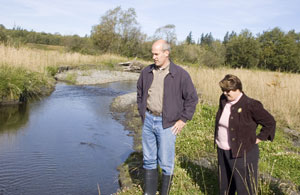
WASHINGTON—Rep. Rick Larsen, WA-02, led an effort this week to request $65 million for the Pacific Coastal Salmon Recovery Fund which is vital to supporting salmon recovery in the Pacific Northwest. In a letter to House appropriators, Larsen and nine other members of the Pacific Northwest delegation made the request to continue supporting the recovery of Pacific salmon which are vital to the region’s economy and ecology.
Tulips: The fields should be stunning this weekend, so it would be a good time for a trip up to the Skagit Valley Tulip Festival. Read about it in our story here.
Live music: The Hootenanny will play today’s current country hits, leaving the classics behind. Hometown Hootenanny presents “On the Radio,” a tribute to country music on Saturday at the Historic Everett Theatre. Read about it in our story here.
On the stage: “Giselle” will be presented at 5 p.m. Sunday at the Edmonds Center for the Arts. “Giselle,” one of the greatest romantic tragedies in ballet, is being staged by two artistic directors who were both Pacific Northwest Ballet leading artists. Also, the leading male dancer was just promoted to principal dancer at PNB. Read more in our story here.
Carving show: The Quil Ceda Carvers present a show this weekend at the Evergreen State Fairgrounds. The show offers a wide variety of carvings to admire or buy, including masks, totem poles, carousel figurines and clocks. There are also woodcarving demonstrations, classes, a juried show and door prizes. Everyone who attends receives a carving goodie bag. The show is 10 a.m. to 6 p.m. Saturday and 10 a.m. to 4 p.m. Sunday. Donation of $5 requested; children under 12 free.
For spring: The spring version of Kla Ha Ya Days is this weekend. Activities include a street fair on Saturday and Sunday in Snohomish. There will be a chili cook-off Saturday and a barbecue competition Sunday with public sampling each day. There will also be entertainment, a carnival and a beer garden. For more information go to www.klahayadays.com.
Go to tea: The Marysville Historical Society’s Spring Tea and Vintage Fashion Show is from 12:30 to 4 p.m. Sunday at the Tulalip Resort Hotel. Admission is by registration only. Seats are $25 each. The best way to register at this late date is to call Ken Cage, historical society president, at 425-308-8707 or society treasurer Meg Engelter at 425-314-3706.
Make flowers: Kids and teens ages 9 and up can make beautiful and intricate crepe paper flowers on Sunday at 2 p.m. at the Everett Public Library Evergreen branch. Each participant will receive supplies for three flowers, limited to first 25 children. Get more information here.
Learn about crows: Corvid expert and professor John Marzluff will talk about his 2012 book “Gifts of the Crow.” Marzluff says that crows and other corvids have large brains, which allow them to have complex emotions, think, plan, and reconsider their actions. The event is at 2 p.m. at the Everett Public Library main branch. Get more information here.